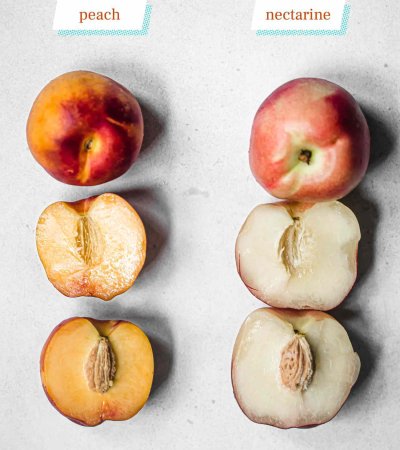Written by Andrew Akhaphong, MS, RD, LD
Updated June 5, 2024
What produce screams spring and summer better than peaches or nectarines?
Peaches and nectarines are produced among 20 states. The top four include California, South Carolina, Georgia, and New Jersey. In 2017 approximately 56% of peaches and nectarines in retail were supplied by California.(1)
In a consumer survey published by the University of Florida Center for Public issues Education in 2017, consumers -(2)
- 33% consume peaches or nectarines once a week or more
- 77% of consumers agree that peaches and nectarines are a good source of fiber for gut health
- 48% of consumers prefer to seek peaches with least amount of fuzz knowing nectarines are an alternative option
Differences Among Them(3)
Peaches and nectarines appear similar but do have a couple distinct characteristics.
Most nectarines available at retailers are developed through crossbreeding peaches with other species of nectarines. Because of this one can find peaches on nectarine trees and vice versa.
Both peaches and nectarines are considered drupes, also known as stone fruits, due to the pit they have.
Unlike peaches, nectarines are known for their fuzz-free skin. The flavor of nectarines are a blend of sweet and tangy while peaches have a more upfront sweetness.

Nutritional Benefits(3)
Peaches have more Vitamin C, Vitamin B2 (riboflavin), and Vitamin K.
Nectarines have more Vitamin B1 (thiamine), Vitamin B3 (niacin), Vitamin B5 (pantothenic acid), and Vitamin B6 (folate).
We often associate Vitamin C to support the immune system and reduce the risk for scurvy (infection of the gums); however, Vitamin C is essential for iron absorption. Vitamin C creates an acidic environment in the stomach. The more acidic it is, the more iron is absorbed.
All the B Vitamins play important roles in metabolism to break down fat, protein, and carbohydrates for energy.
Additionally iron is often thought to be one of the main factors that may cause. Low levels of Vitamin B2, Vitamin B5, and Vitamin B6 may also lead to anemia identified as megaloblastic (large red blood cells). Having large red blood cells reduces blood flow throughout the body. This may cause high blood pressure and an increased risk for a stroke.
In consideration for expecting mothers, Vitamin B6 is critical to prevent neurological and brain defects in newborns.
When to Use(3)
Peaches are softer in texture and are more ideal to make pies, cobblers, crisps, jams, jellies, or condiments like barbecue sauces.
Nectarines are more firm and can hold up better to cooking methods such as poaching and grilling.
Ginger-Lime Grilled Chicken with Nectarines
By Food Network Kitchen
What You Need
- 8 skin-on bone-in chicken thighs
- 1 teaspoon fresh ginger, grated and peeled
- 2 tablespoons fish sauce
- 1 tablespoon packed light brown sugar
- 2 teaspoons lime zest
- 1 tablespoon lime juice
- 1-½ teaspoons chili-garlic sauce
- Salt to taste
- Ground black pepper to taste
- 4 firm nectarines, thinly sliced
- ½ cup fresh torn mint
- ¼ cup roasted peanuts, chopped

What You Do
- Preheat a grill to medium high and prepare for indirect grilling: On a charcoal grill, bank the coals to one side. On a gas grill, turn off half the burners. Toss the chicken with the ginger, 1 tablespoon fish sauce and 1 teaspoon each brown sugar, lime zest, lime juice and chili-garlic sauce. Season with salt and pepper. Place the chicken skin-side up on the cooler side of the grill; cover and cook until a thermometer inserted into the thickest part registers 165 degrees F, about 20 minutes. Move to direct heat and cook, uncovered, flipping occasionally, until the skin is charred and crisp, about 5 more minutes.
- Meanwhile, make the dressing: Whisk 2 tablespoons water and the remaining 1 tablespoon fish sauce, 2 teaspoons brown sugar, 1 teaspoon lime zest, 2 teaspoons lime juice and 1/2 teaspoon chili-garlic sauce in a large bowl. Whisk in the vegetable oil.
- Add the nectarines, mint, peanuts and 1/4 teaspoon salt to the bowl with the dressing; toss. Divide the chicken and nectarine salad among plates.
References:
- Peaches. Agricultural Marketing Resource Center. Updated April 2024. Accessed June 4, 2024. https://www.agmrc.org/commodities-products/fruits/peaches
- Harders K, Rumble J, Bradley T, House L, Anderson S. Consumer Peach Purchasing Survey. University of Florida. 2017.
- The differences between peaches and nectarines. Lane Southern Orchards. May 11, 2023. Accessed June 4, 2024. https://lanesouthernorchards.com/blogs/news/the-differences-between-peaches-and-nectarines





